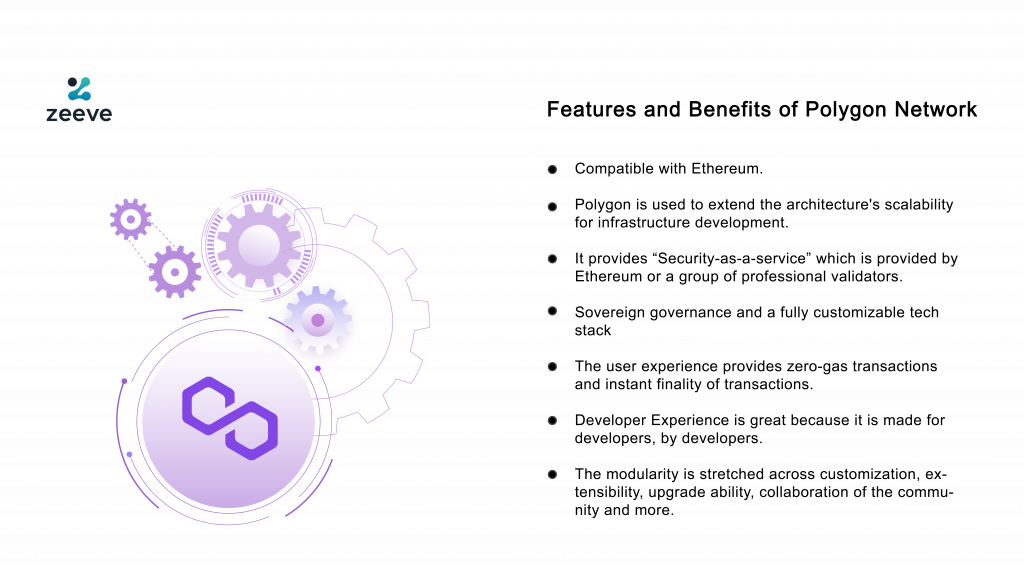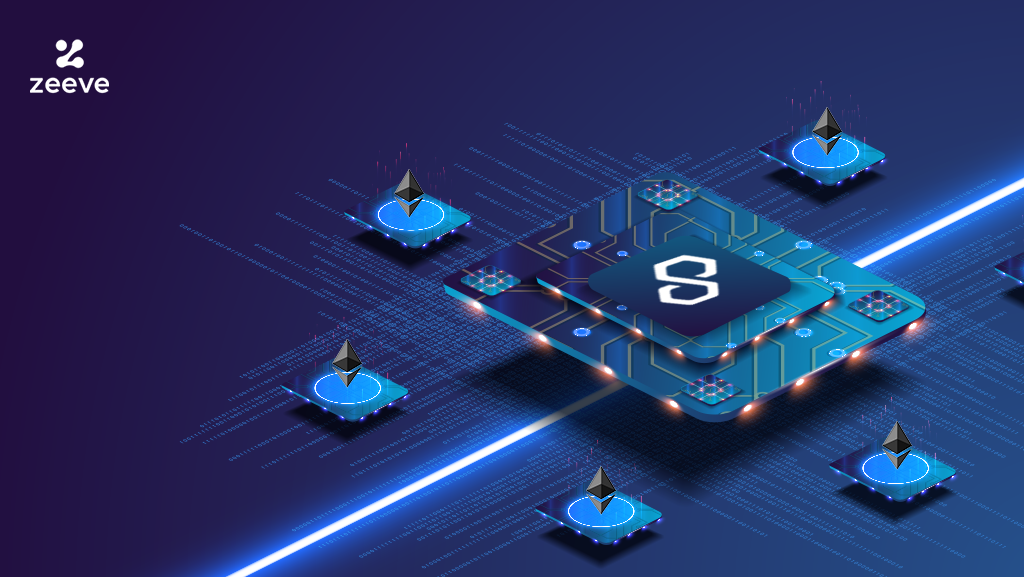The Ethereum network had been the most popular of all blockchain protocols. However, congestion and other issues were beginning to surface with more users on the network. The addition of layers of architecture was thought to alleviate some of the major problems such as scalability, security, high gas fees and so on. Hence, Polygon network was designed as an external protocol that makes the Ethereum blockchain work better by making it lighter and faster and also to reduce gas fees for the users.
Though Polygon acts as a Layer-2 scaling solution for the Ethereum blockchain/root chain, the major work is performed by 3 layer architecture under Polygon.
3 Layer architecture of Polygon is essential to activate the Proof of Stake (PoS) mechanism on the Ethereum blockchain.
But before we dive into the 3 Layer architecture of Polygon in Ethereum, I want to make you understand how Polygon works in Ethereum.
Polygon (MATIC) refers to itself as “Ethereum’s internet of blockchains.”
It is the most popular Ethereum Layer-2 Scaling solution with a prospering Decentralized Finance (DeFi) environment.
Zeeve helps with Polygon Node deployment, supporting emerging startups and enterprises to build, launch, and maintain the security of Decentralized Apps.
The below article extensively covers Polygon (MATIC), how it runs on Ethereum and explains 3 layer architecture of Polygon –
Polygon (MATIC) in Ethereum –
What is a Polygon?
Polygon is a set of protocols and frameworks designed in a way to connect Ethereum and other non-conflicting blockchains. Moreover, Polygon also operates on a hybrid Proof of Stake (PoS) and Plasma chains.
Being a stack of protocols, Polygon is designed in such a way that it can fix scalability issues of the Ethereum blockchain. A point to note here is that it solves network challenges of the Ethereum blockchain on a separate Ethereum blockchain.
Later, post-processing, the transactions by Polygon are returned to the Ethereum blockchain. In this process, Polygon expedites transactions while lowering their costs.
Polygon users don’t have to worry about any network congestion while interacting with any decentralized applications (DAapp)
Founders of Polygon –
The former name of Polygon was Matic Network. It is the brainchild of Jaynti Kanani, Sandeep Nailwal, and Anurag Arjun, in 2017; later on, Serbian engineer Mihalio Bjelic joined as a co-founder.
The change from Matic Network to Polygon happened in February 2021.
MATIC token is the native cryptocurrency of Polygon’s network.
In the first round of the marquee list of investors, Polygon raised $450 million, including over 39 investors. From the list of 39 investors, two angel investors are Balaji Srinivasan and Mark Cuban.
19,000 decentralized apps (DApps) are running on the Polygon network, which increased 6x since October 2021.
A significant issue with Ethereum –
The primary issue with the Ethereum blockchain is network congestion which makes the blockchain of Ethereum slower and discourages users from engaging with smart contracts.
As the Ethereum blockchain is slower, this limits the transactions per second, which are hardly 17 transactions per second. On Ethereum, there is a transaction cost on each transaction which is called gas fees.
During network congestion, gas fees rise quickly, creating another massive issue for those using Decentralized Finance (DeFi) apps and Non-Fungible Tokens (NFT) for buying, transferring, or swapping tokens on Ethereum.
How does Polygon solve the Ethereum problem?
Polygon can make things better for Ethereum by cutting down the gas fees costs and scaling the transaction process on the side chains. Polygon can handle 65,000 transactions per second compared to Ethereum, which can handle hardly 17 transactions per second.
The average transaction fee of Ethereum is around $15 per transaction, and the gas fees for users can be done in pennies with the help of Polygon. Because Polygon holds different protocols, including Zero-Knowledge (ZK) proof here, users can use the best scaling option as per their use.
Zero-Knowledge proofs are cryptographic primitives used to verify another verifier regarding a statement’s validation. Here the prover doesn’t require to provide additional information other than the statement is considered true.
Matic networks started using plasma chains which are lighter and more secured compared to side chains. The plasma chain is the secondary blockchain that runs along with the primary blockchain. Here, Ethereum is the “primary” blockchain and is also known as the “parent” blockchain. The plasma chain helps communicate with the primary blockchain and securely move the assets.
The Proof of Stake (PoS) blockchain bridge was introduced by Polygon, which will help developers create dApp on one platform and receive benefits from another platform.
As the batch of transactions is processed on the PoS blockchain, the load on the Ethereum block gets eliminated. Because the transactions are not batching on the primary chain, this makes the Ethereum faster and lighter.
For those transaction batches running off the chain, ZK rollups create validity proofs and verify each bundle of transactions for accuracy. This approach helps in saving time and also reducing gas fees.
Optimistic Rollups or Fraud-proof protocols self-execute whenever a fraudulent transaction is discovered. Thus, the protocol helps find the right transaction from the available data and reflects on the primary blockchain.
The user who updates transactional data on the primary blockchain requires to stake ETH. The ETH stake will be slashed if any user submits fraudulent transactions on the primary Ethereum blockchain.
Why only Polygon for Ethereum?
A Polygon is the plasma chain, which is a secondary network; it is not in competition with Ethereum. But the dependency of Polygon is more on Ethereum blockchain. Polygon network helps to leverage the mass transactions of Ethereum.
Why is Polygon Layer-2 required for Ethereum Layer 1?
Running Polygon as a Layer-2 scaling solution on Ethereum Layer 1 seems complex. In simple words, Ethereum Layer 1 defines base blockchain architecture. Polygon Layer-2 defines an overlaying network on top of the base blockchain.
Polygon Layer-2 scaling solutions interact with the Ethereum base blockchain to make it lighter and faster and increase the speed and accuracy of the Ethereum base blockchain.
This makes Ethereum base blockchain lighter, faster, and cheaper for gas fees.
Ethereum blockchain was designed as an auction model that could encourage users to bid on transactions and will be included in the next block. Thus, the design of the Ethereum blockchain auction model increased transaction costs because of network congestion.
The Polygon Layer-2 scaling solution doesn’t only focus on speed and accuracy. But the purpose of Polygon is to link all Ethereum Virtual Machine (EVM), which are non-conflicting blockchains with each other and thus, benefitting from different blockchains to all developers with minimal conflict.

The three-layer architecture of Polygon POS Network –
1. Staking Contracts
2. Heimdall Layer
3. Bor Layer
Before, I start explaining the three-layer architecture of the Polygon PoS network. Let me explain where do those layers help the help Ethereum Blockchain –
To activate the Proof of Stake (PoS) mechanism on the Ethereum blockchain, staking contracts are deployed on the Ethereum blockchain. And a set of validators that runs are Heimdall and Bor nodes. Ethereum is the first base blockchain where Polygon supports as a secondary chain making it a Layer-2 scaling solution by increasing the Ethereum blockchain speed and accuracy.
Now, let me explain each layer as below –
1. Staking Contracts –
As mentioned above, activating Proof of Stake (PoS) can be done by staking contracts on the Ethereum blockchain.
The Staking contracts come with the following features –
- MATIC token can be staked by any user on the staking contracts on the Ethereum mainnet and become a validator.
- The user on the Polygon Network can earn staking rewards for validating stake transitions.
- The slashing of tokens is only enabled when the activities like validator downtime, double signing, etc., are performed.
- The user can save checkpoint transactions on the mainnet of Ethereum blockchain.
2. Heimdall Layer –
Heimdall nodes run parallel to the Ethereum blockchain. Heimdall nodes monitor the staking contracts deployed on the Ethereum mainnet and commit to the Polygon network checkpoints. Also, Heimdall is based on the Tendermint blockchain.
Heimdall Layer works as the Proof of Stake (PoS) validation layer, which handles the accumulation of blocks produced by Bor in a Merkle Tree and submits the Merkle root periodically to the Ethereum blockchain/root chain. Here, the checkpoint transactions are considered when periodic submissions of snapshots happen on the Bor sidechains.
For two reasons, checkpoint transactions are required –
1. Providing finality on the Ethereum Blockchain/root chain.
2. Provide proof of burn while withdrawing the assets.
3. Bor Layer –
Bor Layer is responsible for accumulating transactions into blocks as it is a block producer for the Polygon’s sidechain. It is a basic Geth (Go Ethereum) implementation where the custom changes are done in the consensus algorithm.
Bor Layers are also known as a subset of validators and shuffled by Heimdall validators from time to time via committee selection termed span in a Polygon.
Blocks are produced at the side chain and the Bor node, where all Ethereum Virtual Machines (EVM) are compatible. Heimdall nodes validate blocks produced by the Bor from time to time. And a checkpoint transaction that consists of a Merkle tree hash of all blocks on Bor is committed to Ethereum from time to time.
Closing Thoughts –
Polygon reflects a promising future by supporting Ethereum, DeFi, dApps and full support for Ethereum Virtual Machines (EVM). Thus, we will be able to see an extensive inflow of projects flourishing on the Polygon.
Zeeve for Polygon Node Deployment –
Understanding “decentralizing the web” is complicated. However, you cannot ignore the importance of Polygon Node. Zeeve is a blockchain infrastructure management platform that supports blockchain startups and enterprises to build, launch, and securely maintain Decentralized Apps. Thus, its services can be used for Polygon Node deployment. Zeeve provides its best blockchain services to businesses by providing transparency, efficiency, security, and infrastructure management support.





















